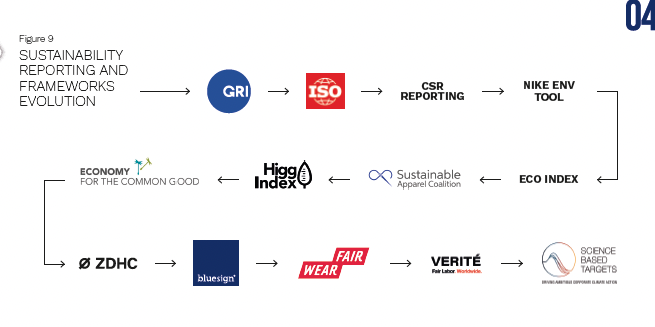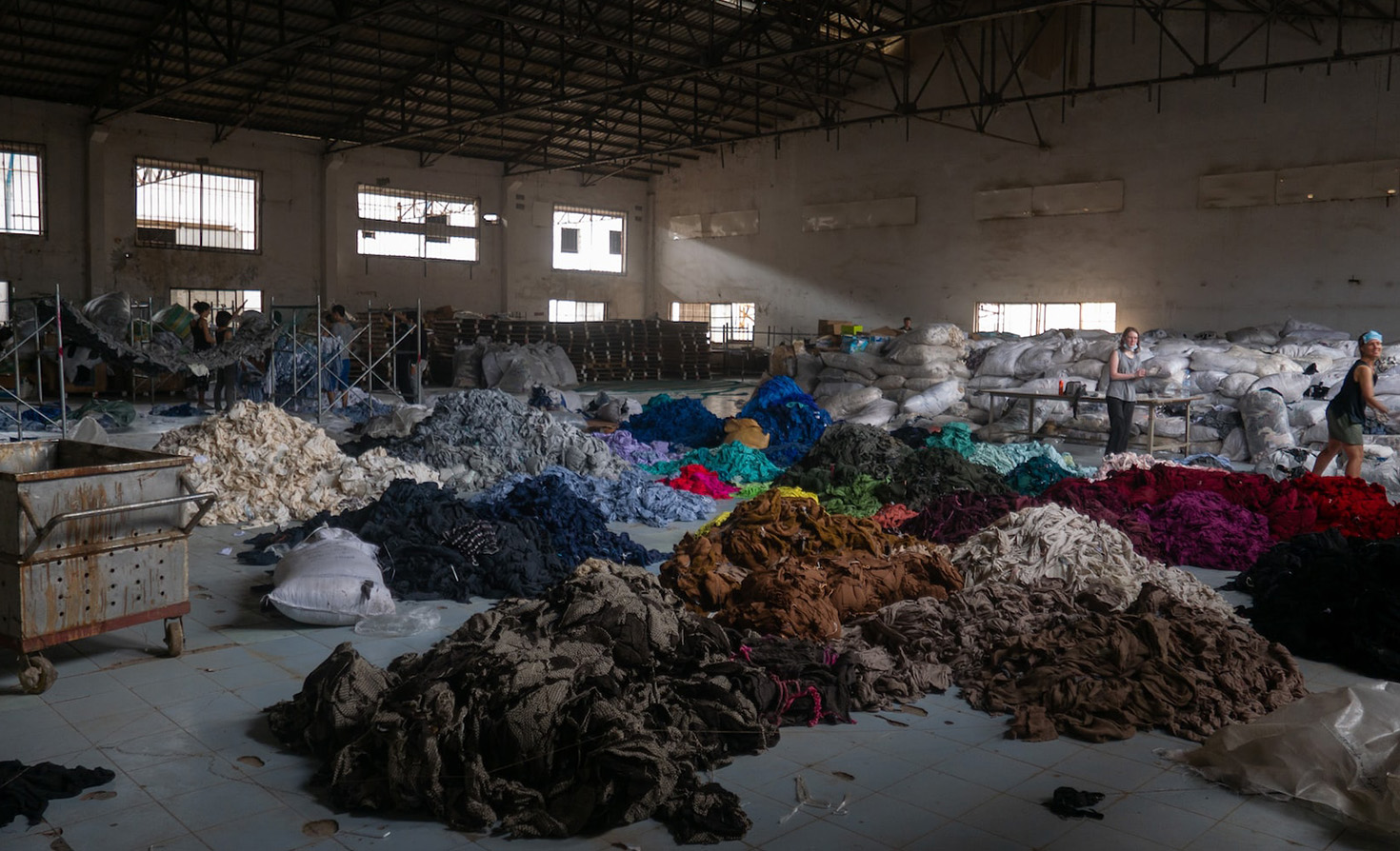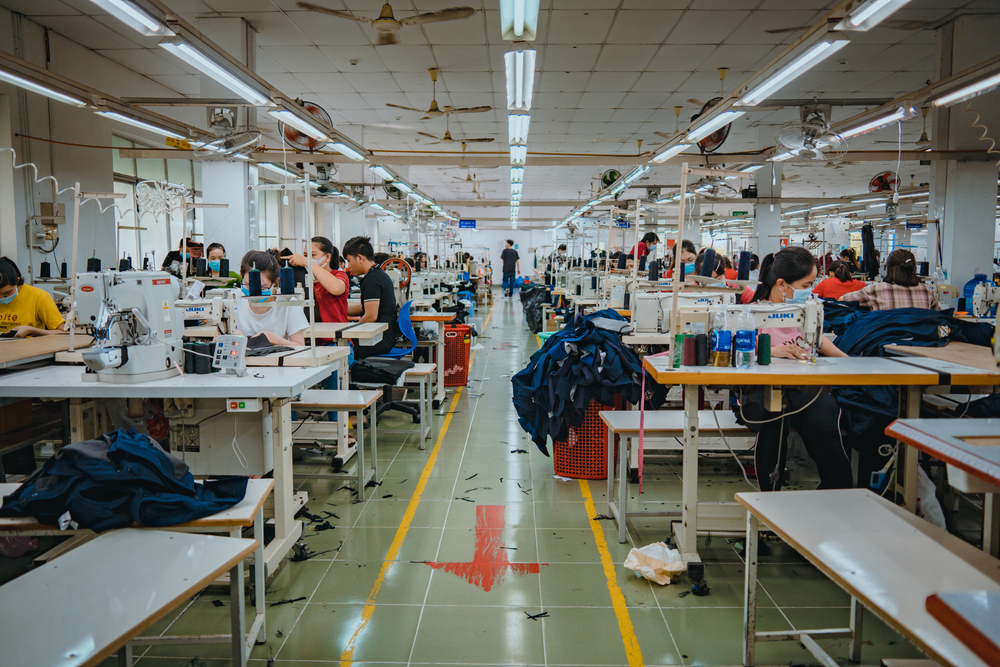This is an excerpt from “Made with Bluesign — Enabling a Better Future.” It is published here with permission.
What sustainability progress has the textile, clothing and footwear industry made in the past 20 years? What should the industry be doing right now? What should the industry prioritize for the next 20 years? Who is responsible for setting these priorities? Will the industry transcend competition and band together? If so, how?
These questions are bigger, and far more complex than they seem at face value.
And the answers, I have discovered, lie in wait, underneath oversimplified sustainability marketing, inadequate economic modeling, reductive sustainability concepts and actions, brutal labor arbitrage, ecological ignorance, social and economic inequality and the relentless pursuit of economic growth.
Writing about this subject in a truly effective and informative way would require objective assessment of hundreds, if not thousands, of problems and solutions spanning climate science, ecology, sociology, psychology, anthropology, politics, economics, materials science, chemistry and engineering. Truthfully, it is probably a job for an advanced neural network capable of analyzing what is currently incalculable — that is, if we could amass the breadth, volume and quality of data required to train it, which this book reveals we currently do not.
It is easy to get entangled in the weeds of this subject, which deserves to be delivered in the words of experts from every interrelated field. My role here is to frame the information shared in the 22 interviews, supplemented by data and findings from industry reports and published climate science, into useful information that cuts through the sustainability fluff — of which there is tonnes, and tonnes … and tonnes.
What sustainability progress has the textile, clothing and footwear industry made in the past 20 years? What should the industry be doing right now?
Although the aim of this book, ostensibly, is to capture the sustainability views of Bluesign’s partners and peers who have joined them on their 20-year journey to date, it has become patently clear that this book stands for much, much more. Starting with the words of Peter Waeber, founding Bluesign was “not a career choice.” It was an “essential service.” A responsibility.
And so is sustainability.
Industry trends
The critical event snapshot infographics demonstrate how recent the sustainability era’s birth is, and how fragmented it is across economic, material and geographic boundaries. Following the invention of polyester (the new “silk”) in the 20s, mass production grew after the Second World War in the 1940s and was followed by the use of what we now know to be harmful ingredients to create durable water repellent (DWR) textiles and non-stick materials in the 1950s.
The environmental analysis that would eventually demonstrate the full impact of carbon-fueled mass production only came decades after in the 1970s, intensified by mounting evidence throughout the ’80s and ’90s.
At the turn of the century, human and animal illness and environmental pollution led to implementation of the first dedicated sustainability frameworks for the textile, clothing and footwear industry (Figure 9).

This would appear to mark the beginning of the sustainability era, although the scientific discovery of the greenhouse phenomenon had occurred in the 1800s, and IPCC climate reports had assessed global environmental changes since 1990 and made repeated recommendations (in 1990, 1995 and 2001) for emissions reductions, which they continued to make (in 2007, 2014 and 2021).
Most recently, toxicity of plastic has been questioned, with textile microfibers present in marine habitats. Research by Ecologist Mark Browne published in 2011 “suggests that a large proportion of microplastic fibers found in the marine environment may be derived from sewage as a consequence of washing of clothes.” Public outcry reached fever pitch following the broadcasting of “Blue Planet II” in 2017, and we are now entering a new era of plastics research and proposed regulation.
The sustainability era
When talking about the sustainability era, it is useful to distinguish between multiple industry phases: recognition, assessment, quantification and action. Broadly speaking, recognition happened in the ’80s and ’90s, following ethical then chemical breaches in the textile, clothing and footwear supply chains. Assessment began in the 2000s with the Bluesign Input Stream Management approach, followed by Nike’s Environmental Apparel Design Tool and the Outdoor Industry Eco Index. However, the Tool and Index analyzed environmental, not social, sustainability factors. Assessment took a further leap in the 2010s with industry-specific tools spanning social and environmental assessment in the form of the Higg modules. Higg, in addition to chemical safety management (through Bluesign and later, ZDHC) and the Science-Based Targets initiative, had created a collective framework for sustainability quantification and target setting by the late 2010s. Now, I contest, we are entering the action phase, concurrent with the “code red for humanity” declared following the latest IPCC climate report.
Sustainability era initiatives
Early recognition and quantification of the industry’s sustainability problems happened mostly within the manufacturing sector.
The onus was on mills and manufacturers, rather than brands and retailers, to pass audits and manage the bulk of the industry’s resources and processes. That was, until the Higg Index was established in 2012. At that point, brands became more engaged in value-chain-wide quantification, and subsequently, target setting.
In the 2010s phase of the sustainability era, whilst Higg module use picked up pace, legacy barriers remained (and still do); including siloed departments, fiduciary obligations, stubborn corporate culture, climate denial and greed…
The individuals and companies facing these barriers and willing to explain their strategy for overcoming them form the book’s substance.
This substance is actions, declarations and results — all with a common thread: demonstrable and quantifiable environmental, economic and social benefits. But in this time of climate crisis, “benefit” must give way to “most beneficial” and here, the “substance” is sorted to understand what the industry priorities should be.
Using recycled materials
Recycling is a sustainability action that generates tremendous favor and allegiance, but offers comparatively small environmental benefits; as demonstrated by Project Drawdown and the World Apparel and Footwear Life Cycle Assessment Database.
Recycling is a tangible action for consumers, and no doubt alleviates at least some purchasing guilt: “If it’s recycled, it’s sustainable, right?” Recycling is also an emotive subject, with a strong public perception that recycled PET helps clean up our oceans.

![]()
![]()
![]()
![]()
This seems to contribute to increased consumer demand for recycled products, despite their limited impact on tackling climate change.
This misconception is both a consumer and industry problem.
The interviews show that recycling and circularity are absorbing a tremendous amount of industry bandwidth, having a potentially disproportionate influence on product, material and marketing decisions.
Solutions to this bias include setting science-based targets (which the Higg MSI and product modules are compliant with) to ensure that the most urgent climate issues are addressed within the business’ scope and in line with the Paris Agreement. Plastic blindsightedness is exposed in the book as a significant threat to tackling the priority outlined in the latest IPCC report: reducing carbon emissions.
Evading emissions
Brands are bound to satisfy shoppers’ desires for recycled materials, take-back schemes and the like — it feeds their bottom line. But equally true is this: the textile and manufacturing phases of products cause the biggest environmental impacts, and are (in almost all cases) not directly controlled by brands or retailers.
By outsourcing production, the visibility, ownership and understanding of social and environmental impacts has been delegated. This was beneficial in the brand mania of the ’80s and ’90s, when bigger margins from cheap production abroad boosted marketing budgets and led to exponential sales growth — all without the hassle of managing production.
But it is less helpful now, with the social and cultural damage of labor arbitrage, piles of waste from cut-price high-volume production and rising air and water pollution; causing a climate and humanitarian crisis that is no longer invisible. Because brands feed shoppers’ desires — from ideological to sartorial — they bear their woes, too. Shoppers want to know what part brands play in the climate crisis and what they are doing about it.
This is where brands and retailers face a conundrum: be swayed by consumer opinion (and its buoyancy impact on sales), or listen to climate science and educate customers (to change purchasing behaviors). Historically, the former has dominated the latter (see “Using recycled materials,” above).
Consumers have been misled, with a mix of willful ignorance and underestimation of the most urgent sustainability actions needed now, and for the next 20 to 30 years. One of the reactions to this has been the U.K. government Competitions and Marketing Authority (CMA) issuing a “green claims code” and putting businesses on warning over greenwashing.
Their research is ongoing and examines green claims that are unsubstantiated or that omit information in product labeling, potentially contravening consumer law. A number of consumer marketing solutions are now emerging, bridging the gap between traditional LCA data and consumer product information, to provide clearer product labeling.
Reducing emissions may not be a juicy marketing story compared to plastic rescued from oceans, but this must not stand in the way of emissions reduction being the main focus operationally for all stakeholders across the value chain.
The most significant scope for emissions reductions is behind the scenes by default, because they are highest in the textile creation, and assembly phases.
The industry-wide science-based targets are: 30 percent GHG reduction in all three scopes by 2030, net zero by 2050 and alignment in following the Greenhouse Gas Protocol across the industry value chain. The U.N. Fashion Industry Charter for Climate Action (comprising eight working groups) is advocating for the adoption of this protocol by industry stakeholders, and has outlined milestones and levers in their Decarbonizing Fashion presentation in June 2021.
Slash emissions first, then focus on the rest
The No. 1 sustainability priority must be to switch to renewable energy and reduce total energy use in the world’s biggest textile, clothing and footwear production hubs.
In 2019, almost 80 percent of the world’s clothing exports by value (not volume) were from just four countries: the EU and China (around 30 percent each), and Bangladesh and Vietnam (less than 10 percent each). Similarly, 80 percent of world textile exports were from four countries: China and the EU (30-40 percent each), with India and the U.S. at around 5 percent each. A picture is forming, suggesting China and the EU should be the biggest targets for slashing industry emissions via conversion to renewable energy sources.
Fashion really is fickle.
Some companies in this book are already well on the way, with 100 percent renewable energy in use at Saitex International in Vietnam, and at Vaude’s factory in Germany. In fact, Saitex’s CEO, Sanjeev Bahl, referred to this as “not difficult to achieve,” but it is clearly infrastructure dependent. For manufacturers relying on national grids for energy, government investment in renewable energy infrastructure and divestment from fossil fuels is central to solving the rising emissions problem. Efforts to apply such pressure include the UN Fashion Industry Charter for Climate Action (referenced above), calling on governments to provide renewable energy infrastructure — but this is a request for action, rather than an enforceable obligation. A European Central Bank report published in September 2021 calculates that a low-carbon economy is cheaper than the costs of climate change (using the kind of language that resonates with economics-focused executives) and could trigger increased focus on tackling emissions. But what follows will likely be a battle to secure investment to mitigate climate change for what will no doubt be seen as long-term benefits (i.e. way-off-in-the-distance and not-likely-to-help-our-bottom-line-right-now).
The biggest exporters — the biggest emitters?
Because textile and clothing exports are reported in value, not volume, the “biggest” exporter might not create the most environmental impact. The relationship between value and volume is not clearly defined in publicly available data, but the WTO has published details of the largest exporters of textiles and clothing (separately), which reveals that: China, the European Union (EU), and India remained the world’s three largest textile exporters in 2020.
Together, they accounted for 65.8 percent of the world’s textile exports. For clothing, China, the European Union, Vietnam, and Bangladesh remained the world’s four largest exporters in 2020, accounting for 72.2 percent of the world market shares.
Some deductions about the countries with the highest impact could be hypothesized based on the types of products produced and their typical unit prices. Bangladesh produces predominantly value-sector products and fast fashion at very low prices, meaning that its volume of production (and impact) per export dollar may be higher than the EU (which generates more revenue due to higher unit costs), for example.
Saying this, Bangladesh produces relatively low quantities of textiles — a segment of the value chain with high emissions levels — which may theoretically counteract its high manufacturing volumes. This serves to illustrate the complexity of environmental assessment based on production locations and export value at an industry level; additional data could be helpful to inform industry decision-making on where emissions reductions and environmental resource management are most likely to provide the biggest, quickest gains.
Emissions targets — China and beyond
Based on the WTO statistics just referenced, it appears the industry should unify efforts to lobby the Chinese government, in particular, to accelerate renewable energy infrastructure. China’s coal consumption is the highest in the world, and is yet to peak (projected in 2025) before beginning to decline in 2026.
In 2020, China’s textile exports accounted for 43.5 percent of global exports, and 31.6 percent of global clothing exports, meaning decarbonization of China’s energy supply would dent not just fashion’s emissions, but those of all global manufacturing.
[At the United Nations General Assembly on Sept. 21, 2021, president Xi Jingping declared an end to its financial support for new coal power projects overseas. But China still hosts over half of the world’s operating coal fleet, which is unaffected by the announcement.]
Beyond China, the industry should focus on the EU, Vietnam, Bangladesh and India to accelerate renewable energy infrastructure, and optimize energy efficiency to tackle the largest sources of emissions.

Industry-level changes were deemed by interviewees to require collective bargaining, with calls for collaboration instead of competition from Michael Preysman, Delman Lee, Eva Karlsson and many others. No single actor — despite their size — can achieve this, according to Kilian Hochrein, who recounted previous failures, even by the world’s largest brands.
An additional and more accessible emissions reduction lever is investment in infrastructure to reduce energy usage in direct operations. There are many examples of this in this book, ranging from ISKO’s R-TWO textiles to Saitex’s Industry 4.0 operations, DyStar’s liquid indigo solution and Vaude’s 100 percent renewable energy powered factory in Germany.
Closing reflections
Views from industry experts on the solutions to sustainability inertia are varied.
A commonly stated one is the need for greater transparency, along with more comprehensive and accurate data collection.
This is believed to be important for better informing consumers about impact optimizing processes and setting more accurate climate targets.
Therefore, “transparency” has different meanings and aims, depending on the stakeholder.
Can transparency deliver sustainable transformation?
But, ultimately, with profits being the dominant business priority it seems business as usual will prevail (as Eva Karlsson and Eric Hopmann said, it costs nothing to do environmental [and therefore social] harm, but it is relatively expensive to be “clean”). It is inescapable that even with transparency, prevailing western economic models dictate that continued economic growth and ever increasing profits is the definition of business success, and it is the metric by which CEOs live or die. Therefore, knowing the business’s impact (even in extreme detail) may have no influence on action to mitigate it. That is, unless doing so will provide economic benefit and not doing so will pose a short-term risk to the bottom line. In essence, unless new economic models and definitions of financial success are adopted, reducing environmental and social impact will not be a business imperative. An antidote to this is Ryan Gellert’s words and actions … sometimes sticking to sustainability commitments means profits will decline, requiring CEOs to be bold and courageous enough to convince shareholders that such profit reduction is not a failure, but a fundamental aspect of building a resilient, long-term business.
But this is Patagonia, and next to this example are dozens of other very public ones demonstrating that CEOs who preside over brands with sliding profits are swiftly shown the door. In late 2021, ASOS’s CEO of six years “stepped down” (no reason was given for the departure) after a year of record profits was followed by a stark post-COVID profit slump and slash in share price. When he joined the company 12 years ago annual sales were $300 million. He leaves with annual turnover at almost $5.5 billion. Fashion really is fickle.
Mindset and sustainability inertia
There are a couple of findings from the interviews that merit additional focus. First is the repeated call for a change in “mindset” or a “mind shift.”
This is a tricky concept to quantify and define, but I gleaned from the interviews that these calls were in response to the dogged human resistance to behavioral change. I am left with the impression that this is the biggest enemy of transformative sustainable actions. This manifests in many examples throughout the interviews. If I had to categorize them, I would say they relate to legacy knowledge, positive technology bias, and willful ignorance.
Breaking these down further, chemical formulation choices, for example, are influenced by legacy knowledge. Often new, less toxic chemical formulations (requiring updated handling techniques) are rejected due to legacy expertise in handling the older, more toxic chemicals (and a marginally lower face-value cost). Other examples of legacy knowledge include sticking to “business as usual” and tackling sustainability piecemeal in isolated departments or initiatives, like sustainability strategies that address only specific products or materials, rather than implementing sustainability from a strategic and business-wide viewpoint. It is the opinion of Kilian Hochrein that business managers are not educated to consider environmental stewardship and impact alongside traditional business metrics, and therefore legacy knowledge of old business models prevails.
Positive technology bias is the belief that we need more technological solutions (whether blockchain ledgers to deliver transparency, or chemical recycling innovations to recycle waste textiles) to solve environmental sustainability problems. Countless experts in this book from the SAC, Greenpeace, manufacturers, mills and chemical suppliers have said that we have all the solutions and information we need. What is lacking is the willingness to take action. The clear industry-wide emissions reduction targets for 2030 and 2050 also demonstrate this — it is action that is lacking.
I think you will agree that the time for talking is over. Onward with action.
Willful ignorance scarcely requires a description, but is evidenced by inaction and indifference to climate change impacts and the rejection of responsibility for addressing environmental and social sustainability, regardless of business model, company size, geographic location or any other factor. It is perhaps summed up best by Patagonia’s CEO: “There’s no law of gravity that defines the standards you’re going to apply, [so] I feel these complex [sustainability] issues come down to intent, and action.” Peter Waeber offers a fashion-specific stance: “Talking about fast fashion brands with big volumes, it may [sound] black and white, but they don’t care. This is the biggest problem we have.”
For all the complexity in the sustainability discussions held throughout the book, it is sobering to conclude that, ultimately, the barrier to protecting the planet from toxic waste, pollution, social inequity and devastating temperature rise is simply decisive action that follows the climate science.
We know the environmental sustainability priority: set science-based targets, implement renewable energy and reduce energy use in specific life cycle phases.
We know the life cycle phases with the biggest impacts: dyeing and finishing, fiber production, yarn and fabric preparation, and assembly.
We know the top countries where these life cycle phases are carried out: China, EU, Vietnam, Bangladesh and India.
We know that worker inequity and child labor have been rampant in fashion supply chains for decades, and are set to increase due to the coronavirus pandemic.
We know that labor arbitrage threatens garment worker livelihoods and maintains worker vulnerability.
We know that without legal implications or significant risk to profits, the actions of most shareholder-driven companies will follow fiduciary responsibility over environmental or social sustainability.
We know we have until 2030 to reduce industry-wide emissions by 30 percent and until 2050 to achieve net zero emissions.
I think you will agree that the time for talking is over. Onward with action.
If you’d like to read the original source of this article please click here Visit Source
